2021 5YR financial and social conditions review for Staff members: methodology, considerations and findings
What is the aim of the 5YR for what concerns salaries?
For Staff members, the 5YR serves to ensure that the financial and social conditions offered by the Organization allow CERN to recruit and retain the staff members required for the execution of its mission from all its Member States (cf. Annex A 1 of the Staff Rules and Regulations, as adopted by the Council).
How do we compare salaries?
The first stage is to analyse and identify our main Staff recruitment markets over the last five years. The conclusions are schematically presented as follows, showing the private sector as being CERN’s main recruitment market. Further analysis has revealed that CERN recruits predominantly from the high-tech sector.
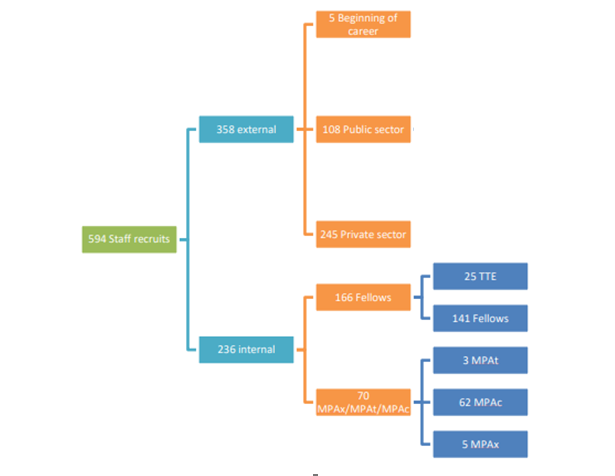
Who carries out the salary comparisons for CERN?
Salary comparisons are divided into two components: grades 1 to 3 are studied as part of the “local salary survey”, which was carried out by Willis Towers Watson; grades 4 to 10, the “international salary survey”, was carried out by the International Service for Remunerations and Pensions ISRP, which is administratively attached to the OECD.
How do they carry out the comparison?
The process is agreed in concertation with the Staff Association and discussed with the Member States at the Tripartite Employment Conditions Forum, TREF. In summary:
- The main recruitment markets for CERN over the past five years are first identified: following the analysis conducted by CERN’s HR department in 2020, the main recruitment market remains the high-technology private sector for this 5YR.
- For the international survey, the selected consultant identifies which countries offer the most competitive salaries among CERN Member States in the private high-technology domain: these were found to be Switzerland and Germany. CERN salaries are therefore compared with salaries in high-technology companies in those two countries.
- For the local survey, salaries are compared with high-technology companies located in Canton de Vaud, Canton de Genève and neighbouring France.
- The CERN reference points used in the comparison are the mid-points of a selection of representative Benchmark Jobs which are then compared, like for like, with industry. This means that the Benchmark Job Descriptions and the promotion guide are used to accurately specify the job content, level of complexity and all other relevant factors.
- Salaries are compared after tax but before the deduction of social contributions. For the private sector, pay includes base salary plus bonuses (on average 20%). For CERN, performance payments are not included.
- Purchasing Power Parities are applied to convert net salaries earned outside Switzerland into Swiss Francs, to account for the cost-of-living differential with respect to Geneva.
- For the international salary survey, CERN’s salaries are compared with net salaries in the high technology sector at the seventy-fifth percentile (P75) market line. This means that 75% of the salaries in the selected private sector market are lower and 25% are higher. For the local salary survey, CERN’s salaries are compared with the net salaries in the high-technology sector at the median (P50) market line (50% of the salaries are higher and 50% are lower).
In total, twenty Benchmark functions were compared against the high tech private sector market: three profiles for the local survey (grades 1 to 3) and seventeen profiles at specific grades (4 to 10). See below for some examples.
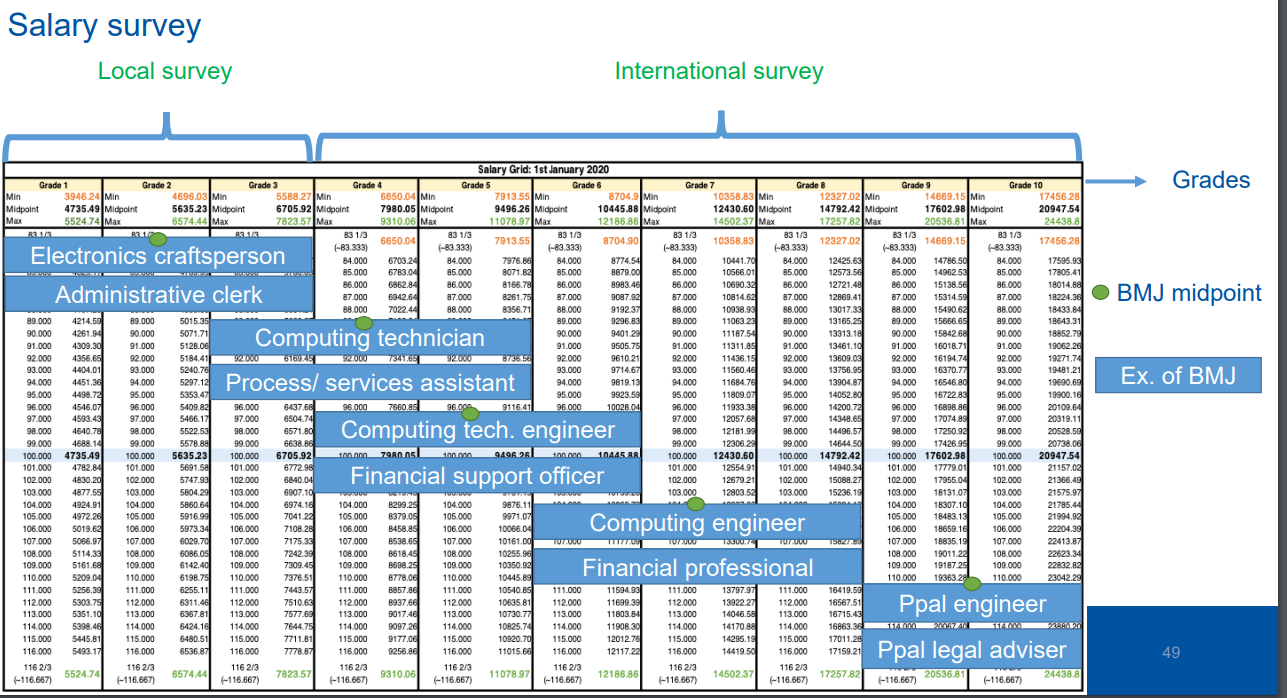
What are the results?
- The local salary survey showed that with respect to CERN salaries for grades 1 to 3, Swiss salaries stand at 92%, and French salaries at 57%, signifying that CERN salaries in grades 1 to 3 are, on average, 8% higher than Swiss salaries and 43% higher than French salaries for equivalent jobs.
- For the international survey, i.e. grades 4 to 10, Switzerland was found to be the most competitive geographical market for all of the studied Benchmark Jobs. The results are summarised in the figures below:
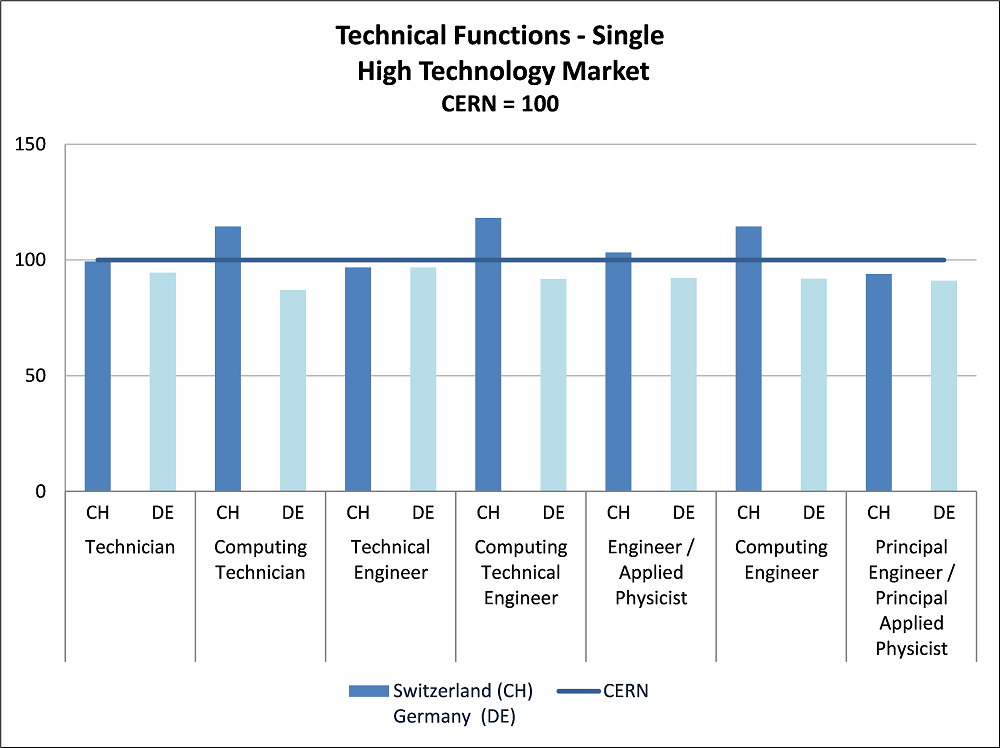
It can be observed that CERN is competitive for the technical functions (from technician to principal engineer), however, the net reference salaries for “computing” profiles are consistently higher in the Swiss high-technology Market. The German net reference salaries (after adjustment of the cost-of-living) are all lower than the respective CERN functions (-3% to -17%).
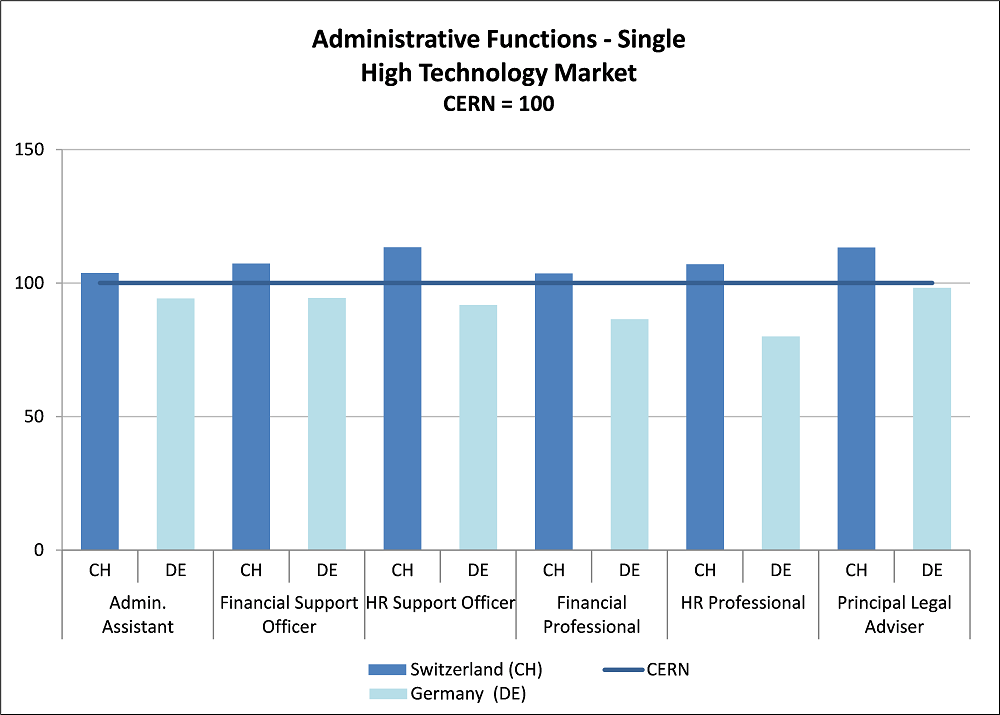
In the administrative domain, net reference salaries in Switzerland are 4% to 13% higher than the CERN reference salaries. The German net reference salaries (after adjustment of the cost-of-living) are all lower than the respective CERN functions (-2% to -20%).
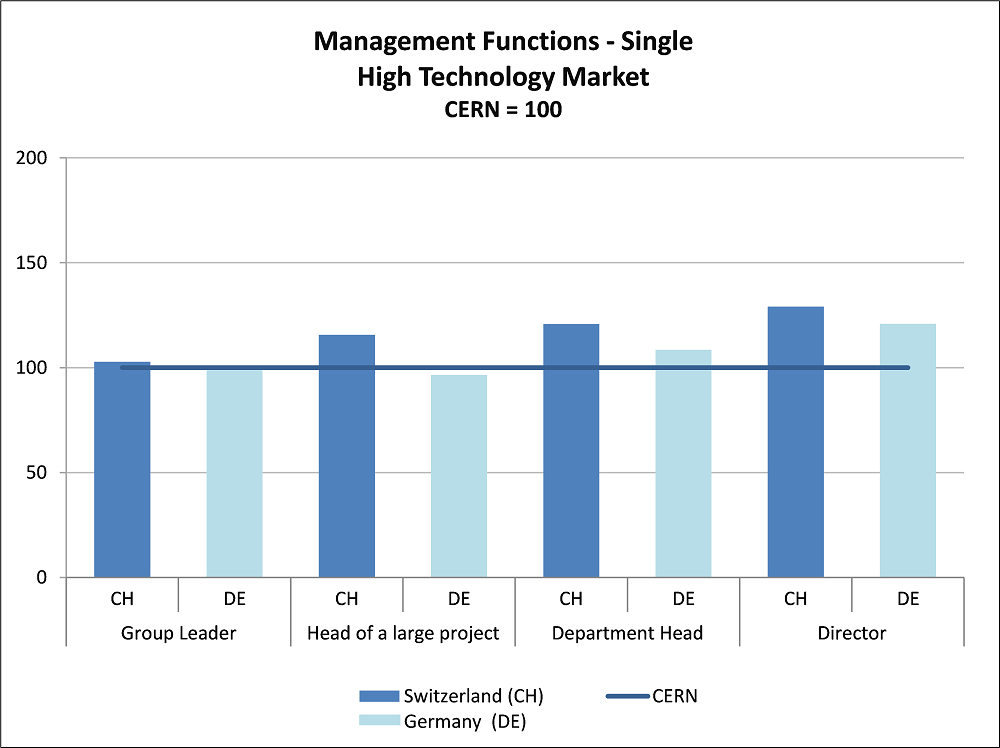
For the managerial functions, the Group Leader is almost on par both with the Swiss and German salaries (adjusted for cost-of-living). For the other managerial functions, there is a marked difference with the Swiss high-technology market, up to 29% at Director level. Also for the Department Head and the Director, the German salaries (adjusted for cost-of-living) are higher (9% - 21%).
Comparison with the previous five yearly review: The international salary survey conducted for the previous five yearly review showed a larger gap. How can this be explained?
The previous 5YR was based on CERN’s former career structure, i.e. prior to 2016 (based on career paths, bands and steps), with a different salary grid and without the formal definition of benchmark jobs that we have today.
For example, under the previous career structure a ‘computing engineer’ would have been in career path E, bands a to c (the ECE zone was excluded from the comparison), while today the same engineer would be in a benchmark job spanning grades 6-7(8), with a broader salary span that also encompasses senior staff (former career path F as well as ECE) and therefore has a higher mid-point. Therefore, even a CERN-to-CERN comparison between the last 5YR in 2015 and today’s 5YR would show a difference, as we are now aligned to the new benchmark jobs model.
The ISRP uses a comprehensive database of approximately 730 companies with almost half a million data points for the two countries compared. For consistency reasons, the ISRP recommends the use the location of CERN’s headquarters, i.e. Geneva, as the reference city for tax, rather than any other Canton (e.g. Zürich which was used for the previous 5YR).
What can we learn from this study?
Several lessons can be drawn:
1. It’s not all about salaries
Numerous studies (e.g. http://media-publications.bcg.com/Decoding-Global-Talent/BCG-2018-Jun-2018-R.pdf, ‘Exhibit 7’) show that salaries are important but that other key factors come into play in attracting and retaining staff. The recruitment and retention report spanning the years 2016-2019 and presented at TREF shows the following key numbers:
- Number of ‘refused offers’ (5.1%) and the main reasons behind these;
- Number of ‘resignations’ (70 of whom 62 were on LD contracts and 8 on IC contracts);
- Number of ‘re-publications’ (i.e. where CERN was unsuccessful in recruiting on the first board, standing at 6.9%).
2. The main challenge is diversity
The main challenge identified in the recruitment and retention report is the ability to hire a diverse workforce, particularly in terms of gender and nationality, and especially from certain Member States, such as Germany. The ISRP report shows that CERN salaries are higher than the benchmark in Germany so the issue is not salaries.
What are the challenges then?
- Talent pipeline
- Although the private high-technology sector is clearly CERN’s main recruitment market, we have strong internal talent pipelines (fellows, students, project associates, trainees etc.) in many fields. Ensuring this talent pipeline is diverse is key to our future success, hence the importance of the Graduate programme review that is currently in progress.
- Dual careers
- The average age of people recruited into staff positions is 34, which means that the individual is likely to have a spouse and children. At this age, relocating an entire family for a 5-year limited-duration contract is not an easy decision to take.
- The CERN contract policy
- Candidates for staff positions often already hold an indefinite contract elsewhere, so leaving this for a 5-year limited duration contract requires a courageous leap of faith.
- Languages
- The market for skilled engineers is already highly competitive, so the additional requirement that candidates from under-represented countries such as Norway or Germany must acquire working knowledge of at least one new language makes the task of recruiting from such countries even more challenging.
3. Despite the above challenges, in 2020 over 20 000 people from across all our Member States applied for 135 staff vacancies. This record figure shows that CERN continues to be attractive.
What are the next steps in the 5YR?
The next stage of the 5YR is the presentation of the Management’s proposals. Based upon the analysis from the recruitment and retention study as well as the data from the salary surveys, and following further concertation with the Staff Association, the Management will formally presented its proposals to TREF in October 2021 following which they have been submitted for approval to the Council in December 2021.